|
|
Art From Dimar with Explanations! :)
These are various pictures of citizens of Dimar from all timeperiods,
with explanations and stories behind each. I'm hoping this will
be a fun way to introduce you to some of the strange facets
of the Dimar, and some features of the planet and the culture
that's evolved there. Pictures are shown with no particular
rhyme or reason.
[ Maps
] [ Arrallins] [ Dimar ] [ Humans ] [ Water ] [ Barryds ]
[ Shiptech ] - All Coming!
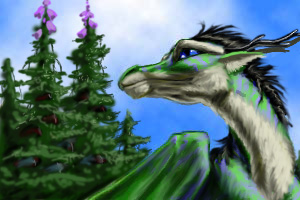 This
is a half breed Dimar sitting in front of a barryd. Half breeds
are relatively rare in the time when Humans and Arrallins moved
to the planet, but become much more common. This fellow is more
regular Dimar than Mul (War Breed), but has enough Mul blood
to branch his horns. (More on horns than you ever wanted to
know coming up...) This
is a half breed Dimar sitting in front of a barryd. Half breeds
are relatively rare in the time when Humans and Arrallins moved
to the planet, but become much more common. This fellow is more
regular Dimar than Mul (War Breed), but has enough Mul blood
to branch his horns. (More on horns than you ever wanted to
know coming up...)
Behind him, a young barryd's twin spires rise, covered in purple
blooms that will eventually (25-100 years) create seed pods
to become abari (suburbs) or whole new barryds (cities). Barryds
are not one kind of plant, but an entire plant AND animal colony.
Barryd-living Dimar consider themselves part of the whole plant.
They are not separate from it, or living off it. They're as
integral a part to the survival of the plant system as the plant
itself, and it is integral to their survival as well. The idea
of one-ness with the world and nature, and especially a living
barryd plant is central to the Dimar philosophy.
 This
human, who has been cosmetically altered himself, is learning
the skills needed to adjust the fur and scale patterns in Dimar
through using The Water. The Water is a set of 'active cells'
immersed in a rich, sugary solution. They are like helpful viruses.
They examine the DNA of whatever creature is in the Water
pool and based on this blueprint can repair the injured animal.
The technology is advanced enough that Dimar often make adjustments
and improvements to their own structures, introducing a new
blueprint to the Water, and then immersing a Dimar or animal
in it to make the changes. An example of a useful change Dimar
made is their Wings. Dimar were originally four legged animals.
Wings were added to the species early in the history of the
planet and honed to perfection over years of adjusting and use. This
human, who has been cosmetically altered himself, is learning
the skills needed to adjust the fur and scale patterns in Dimar
through using The Water. The Water is a set of 'active cells'
immersed in a rich, sugary solution. They are like helpful viruses.
They examine the DNA of whatever creature is in the Water
pool and based on this blueprint can repair the injured animal.
The technology is advanced enough that Dimar often make adjustments
and improvements to their own structures, introducing a new
blueprint to the Water, and then immersing a Dimar or animal
in it to make the changes. An example of a useful change Dimar
made is their Wings. Dimar were originally four legged animals.
Wings were added to the species early in the history of the
planet and honed to perfection over years of adjusting and use.
Any use of Water to adjust a structure is dangerous, however.
Cosmetic changes like fur and scale patterns are the easiest,
and any student of the Healing Arts or Engineering Arts usually
learns this technique first. This human has just completed a
fur color change on this Dimar, and fortunately for both of
them, the Dimar is pleased with the result. This Human will
probably graduate high in his Telkai (engineering) class, because
it's difficult to get blue stripes on a dimar with red and brown
coloring already. Colors in fur tend to be from the same family.
A green and blue pattern, or green and purple pattern is easier
to create in a way that will be stable and recurr year after
year in the coat as it sheds. A red and blue pattern, or a purple
and yellow pattern, if not done well, will eventually fade out,
being dominated by one color or the other. Having a color pattern
that's difficult to acheive is a sign of affluence for Dimar,
and makes them more attractive to (shallow) members of their
species.
.
 In
the first years of Humans coming to Dimar, in order to encourage
friendship and cooperation between the two species, humans in
the Barryds were roomed with unmated Dimar. This tradition continued
throughout Dimar's history of managed housing and housing assignments,
and especially at universities and defense training academies.
Both Arrallins and Humans get along well with the generally
easygoing Dimar species. The Humans and Arrallins find the situation
beneficial, because it's akin to having a housemate with a car
when you don't own one. Dimar housemates generally don't mind
ferrying their wingless firends to various places. Later technological
advancements allow Humans and Arrallins to fly independently,
but in the early days, 'Air Dimar' was the only way to get around
the barryd and some roadless abari areas. All Dimar can fly,
so they had no stairs and no roads suitable for landbound creatures
in the cities themselves - only in areas where they kept herds
of morraks for meat. In
the first years of Humans coming to Dimar, in order to encourage
friendship and cooperation between the two species, humans in
the Barryds were roomed with unmated Dimar. This tradition continued
throughout Dimar's history of managed housing and housing assignments,
and especially at universities and defense training academies.
Both Arrallins and Humans get along well with the generally
easygoing Dimar species. The Humans and Arrallins find the situation
beneficial, because it's akin to having a housemate with a car
when you don't own one. Dimar housemates generally don't mind
ferrying their wingless firends to various places. Later technological
advancements allow Humans and Arrallins to fly independently,
but in the early days, 'Air Dimar' was the only way to get around
the barryd and some roadless abari areas. All Dimar can fly,
so they had no stairs and no roads suitable for landbound creatures
in the cities themselves - only in areas where they kept herds
of morraks for meat.
The only housing problems arise when shiftless Humans are housed
with the fierce and competitive Mul Dimar - the war breed, who
will only tolerate an independent and respectable human living
with them. Arrallins, as a rule, are industrious, and get along
well with the Mul. Most humans living with Mul Dimar just suffer
the expense and buy their own wings. Better than having a housemate
who constantly complains about what a useless weakling you are
just because you didn't happen to be born with wings!
 This
guy's a good example of the wide variety of colors a Dimar can
come in. Originally, Dimar had very few color combinations:
white, black, grey, brown, tawny, golden, dark brown, greens
and reds. But, they are a species as vain as Humans, and with
advanced genetic tinkering, they beautified themselves as much
as humans would if they had the technology earlier. Humans and
Arrallins, when moving to Dimar, were also quick to save their
Nila (money on Dimar) and have all kinds of alterations made
to enhance their beauty. Within 50 years of settling on Dimar,
Humans and Arrallins with blue, green, purple, rainbow, striped,
pinto hair/skin are common. They even pass their coloration
on to their children, as it is installed at the DNA level in
place of their natural color patterns. In this case, this man's
purple marks are not just cosmetic, but mark him as a resident
of Aveila island. The two stripes on the forehead this man was
lucky to inherit, but other humans sometimes get the stripes
tatooed on their foreheads (but not the eyelid as shown here)
when joining the Aveilans. This
guy's a good example of the wide variety of colors a Dimar can
come in. Originally, Dimar had very few color combinations:
white, black, grey, brown, tawny, golden, dark brown, greens
and reds. But, they are a species as vain as Humans, and with
advanced genetic tinkering, they beautified themselves as much
as humans would if they had the technology earlier. Humans and
Arrallins, when moving to Dimar, were also quick to save their
Nila (money on Dimar) and have all kinds of alterations made
to enhance their beauty. Within 50 years of settling on Dimar,
Humans and Arrallins with blue, green, purple, rainbow, striped,
pinto hair/skin are common. They even pass their coloration
on to their children, as it is installed at the DNA level in
place of their natural color patterns. In this case, this man's
purple marks are not just cosmetic, but mark him as a resident
of Aveila island. The two stripes on the forehead this man was
lucky to inherit, but other humans sometimes get the stripes
tatooed on their foreheads (but not the eyelid as shown here)
when joining the Aveilans.
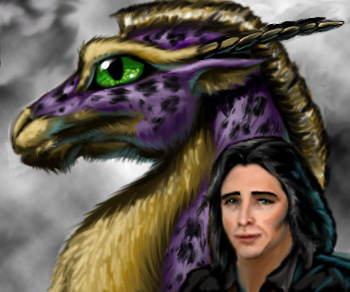 Here's
just another version of the same picture. Here's
just another version of the same picture.
.
.
.
.
.
.
.
.
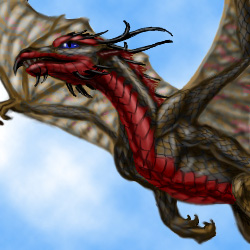 This
is a classic Mulkol soldier. (Mulkol is one of the few remaining
War barryds on Dimar at the time of the arrival of Humans and
Arrallins.) He has only one branch on his horn, so he probably
doesn't come from a prominent noble clan in Mulkol Barryd. However,
he does have a corona - a set of small horns rising from the brow
in front of the main horn. This implies that he was probably member
of a piloting family, running multiple sets of controls for a
large warship. Horns on Dimar and Mul Dimar are not for protection,
like on a goat or deer, but for communication. The solid outer
coating of the horn covers thousands of magnetic receptors that
are routed directly into the brain. The horns allow the Dimar
to both send and receive neuromagnetic signals through the strong
magnetic field of Dimar to psychicly communicate with other Dimar.
There's nothing psychic about it, though. It's like radio, but
uses a type of magnetism that Earth has, but on Earth, it's so
weak that it's nearly useless. This
is a classic Mulkol soldier. (Mulkol is one of the few remaining
War barryds on Dimar at the time of the arrival of Humans and
Arrallins.) He has only one branch on his horn, so he probably
doesn't come from a prominent noble clan in Mulkol Barryd. However,
he does have a corona - a set of small horns rising from the brow
in front of the main horn. This implies that he was probably member
of a piloting family, running multiple sets of controls for a
large warship. Horns on Dimar and Mul Dimar are not for protection,
like on a goat or deer, but for communication. The solid outer
coating of the horn covers thousands of magnetic receptors that
are routed directly into the brain. The horns allow the Dimar
to both send and receive neuromagnetic signals through the strong
magnetic field of Dimar to psychicly communicate with other Dimar.
There's nothing psychic about it, though. It's like radio, but
uses a type of magnetism that Earth has, but on Earth, it's so
weak that it's nearly useless.
Humans and Arrallins, immersed in the powerful field of magnetism
can eventually develop the ability to broadcast and receive
naturally. To speed the process, many colonists to Dimar save
up their money and have Water alterations done to their brains
to gain this ability. It's incredibly helpful when dealing with
Dimar, who have a spoken language, and have learned English,
but prefer to talk in pictures through their psionic abilities.
 This
Dimar female is rarity in two ways: First, she has ram horns that
curl forward. This horn design was induced in Dimar that conquering
Mul Dimar didn't trust, and the process of altering a horn shape
is very painful if not done correctly. With horns bent like this,
it is impossible for the Dimar to interface with the piloting
system of a Mul warship. Basically, this horn design prevents
the Dimar from being able to steal a ship. Generally, conquered
Dimar that Mul used this technique on were used as farmers and
then killed, so finding this kind of horn is rare. Second, she
carries original, natural colors for Dimar - brown and green,
with a white belly. She may have spent a few Nila to get her eyes
dyed to purple, but it may be her natural coloring. Striking and
impressive eyes, like in Humans, are important to Dimar standards
of beauty. Evolution, before the Dimar were even a culture, provided
them with a wide variety of natural eye colors. This
Dimar female is rarity in two ways: First, she has ram horns that
curl forward. This horn design was induced in Dimar that conquering
Mul Dimar didn't trust, and the process of altering a horn shape
is very painful if not done correctly. With horns bent like this,
it is impossible for the Dimar to interface with the piloting
system of a Mul warship. Basically, this horn design prevents
the Dimar from being able to steal a ship. Generally, conquered
Dimar that Mul used this technique on were used as farmers and
then killed, so finding this kind of horn is rare. Second, she
carries original, natural colors for Dimar - brown and green,
with a white belly. She may have spent a few Nila to get her eyes
dyed to purple, but it may be her natural coloring. Striking and
impressive eyes, like in Humans, are important to Dimar standards
of beauty. Evolution, before the Dimar were even a culture, provided
them with a wide variety of natural eye colors.
 These
three must have one heck of a popular apartment! The female
Dimar in the back would be considered a classic Dimar beauty,
the Arrallin beta female has one of the most desirable coat
marking patterns for their culture (diamond on the forehead)
and the human ain't bad either. These
three must have one heck of a popular apartment! The female
Dimar in the back would be considered a classic Dimar beauty,
the Arrallin beta female has one of the most desirable coat
marking patterns for their culture (diamond on the forehead)
and the human ain't bad either.
The Arrallin shown here is a beta, and the common observer
can know this through two main signals: she has no mane, and
she has blue eyes. If her tail was visible, it would lack a
large tuft. Only Alphas grow the thick silky manes and tail
tufts, and always have gold or green-gold eyes. Betas only attain
these features if they use the Water for cosmetic alterations,
and they have to pay a sumptuary tax to the Alphas of their
hive for permission to essentially appear as royalty. The Arrallins
have no trouble spotting a true Alpha from a Beta who is cosmetically
enhanced because of the chemical communications that link all
of them, but for humans and Dimar, it can be downright confusing.
The Dimar has a white undercoat with grey points - dark muzzle,
dark grey underbelly, and a black mane. She probably had black
horns, and may not have had the blue stripes, and may have had
them added via Water later in life.
More on Horns: Many Dimar have twisting spiral, or twisting
smooth horns, like this female here. They end in a single point,
with no brachiations or branches. Single horns allow the Dimar
to interface with ships and warships, but only to drive them.
Brachiations are reserved for tactical data or weapons controls,
so Dimar that were taken as slaves during the Barryd wars had
all their brachiations removed. This allowed them to still move
the ships around - it just prevented them from using the weaponry.
This is the natural configuration for all Dimar horns - Dimar
horns with hook ends or that are bent completely around are
a sign that the family has known war, and was part of a conquered
family. Since most Dimar breeds hate war, hooked horns are worn
with pride, as a sign of survival and strength. Having your
horns hooked when your clan doesn't already have hooked horns
is never done - it's the same as saying 'I'm a child
of a Prisoner Of War (POW)' when you're not!
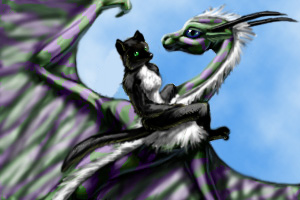 On
the backs of all Dimar, there is a large, furry pouch for carrying
Dimar children. However, when a Dimar, like this young female,
aren't babysitting, humans and arrallins can use it as a seat.
The furry pad that covers the pouch to keep it warm makes a
perfect seat for residents who don't have the Nila (money) to
buy their own wings. Even in later times, it's difficult for
humans to reach the tallest spire rooms of the Barryds without
wings, so as a matter of courtesy, any Dimar who's flying up
gives rides to Humans or Arrallins who need the service. On
the backs of all Dimar, there is a large, furry pouch for carrying
Dimar children. However, when a Dimar, like this young female,
aren't babysitting, humans and arrallins can use it as a seat.
The furry pad that covers the pouch to keep it warm makes a
perfect seat for residents who don't have the Nila (money) to
buy their own wings. Even in later times, it's difficult for
humans to reach the tallest spire rooms of the Barryds without
wings, so as a matter of courtesy, any Dimar who's flying up
gives rides to Humans or Arrallins who need the service.
 Since
many Mulkol have serrated scales, and often have scaled protection
even over their pouch area that would lacerate anyone who tried
to ride there, they have to wear saddles to offer this service,
and consider it a disgrace. Barryd leaders assign the duty of
wearing a padded saddle and ferrying residents around only as
a punishment. Humans and Arrallins that live in Mulkol areas often
do themselves the favor of buying wings from Engineering (Tel)
Barryds, just to avoid the constant mockery and derision of the
Mul, who value strength and independence. Since
many Mulkol have serrated scales, and often have scaled protection
even over their pouch area that would lacerate anyone who tried
to ride there, they have to wear saddles to offer this service,
and consider it a disgrace. Barryd leaders assign the duty of
wearing a padded saddle and ferrying residents around only as
a punishment. Humans and Arrallins that live in Mulkol areas often
do themselves the favor of buying wings from Engineering (Tel)
Barryds, just to avoid the constant mockery and derision of the
Mul, who value strength and independence.
 A
beautiful example of color engineering in action. This shy female
is probably not yet used to her new, eye catching pattern. It's
similar to what people feel when they make a radical change
in hair color. At first, they're shy, but soon, they revel in
the new attention. A
beautiful example of color engineering in action. This shy female
is probably not yet used to her new, eye catching pattern. It's
similar to what people feel when they make a radical change
in hair color. At first, they're shy, but soon, they revel in
the new attention.
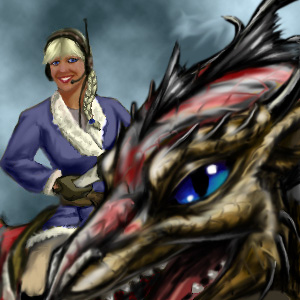 This
Mul male and female human are on fire patrol. Even later in
Dimar's history, controlling the horrible fires that crop up
all over mainland during the dry season is a big job. Imagine
California in summer, times about 100, and you have a Dimar
mainland dry season. Mul tend to focus on war studies and have
little interest in fire fighting. Because of this, their barryds
would often lose all the progress they'd made during the wet
season. Dimar population is always kept in balance with the
size of their barryd and what it can provide, so Mul numbers
remained stable for centuries. Human fire consultants have greatly
boosted their effectiveness in protecting the abari regions
around the central Mul barryds, removing a natural control to
the Mul population. Humans and Arrallins who live at or aid
Mul barryds (which could some day rise again to reconquer the
planet) take a lot of flack at public gatherings for helping
the Mul rise in numbers, but a rational examination of population
shows that Mul populations still rise at a much slower rate
than other Dimar, which are beginning to become crowded on the
smaller islands. This
Mul male and female human are on fire patrol. Even later in
Dimar's history, controlling the horrible fires that crop up
all over mainland during the dry season is a big job. Imagine
California in summer, times about 100, and you have a Dimar
mainland dry season. Mul tend to focus on war studies and have
little interest in fire fighting. Because of this, their barryds
would often lose all the progress they'd made during the wet
season. Dimar population is always kept in balance with the
size of their barryd and what it can provide, so Mul numbers
remained stable for centuries. Human fire consultants have greatly
boosted their effectiveness in protecting the abari regions
around the central Mul barryds, removing a natural control to
the Mul population. Humans and Arrallins who live at or aid
Mul barryds (which could some day rise again to reconquer the
planet) take a lot of flack at public gatherings for helping
the Mul rise in numbers, but a rational examination of population
shows that Mul populations still rise at a much slower rate
than other Dimar, which are beginning to become crowded on the
smaller islands.
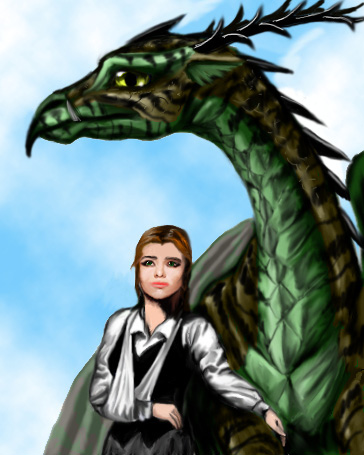 This
is a Mul dimar, and judging from his horns, he's a decendant
of a noble Mul clan. The more brachiations on the main horns,
generally the higher in stature the family is. These brachiations
are not for show, however. They're for piloting a warship, and
monitoring all the activities of an army. Imagine if you could
have tactical information on your army piped to your ship and
directly into your mind for analysis! Each brachiation would
handle a different division in a Mul's army, or a different
function of the flagship. There's more of a story behind this
picture, though, than this young male's horns. His partner for
a Mirrai festival contest has been injured. The Mirrai is like
a trade show for all the Arts and Guilds of Dimar. There are
other, smaller festivals, or specialized events, but Mirrai
is the equivalent of the World's Fair. Every business, study,
art, and science holds shows and contests at the Mirrai. The
fairgrounds themselves are as large as some of the smaller barryds
on Dimar. Winning a prize or displaying your wares at the Mirrai
can make or break your career. This
is a Mul dimar, and judging from his horns, he's a decendant
of a noble Mul clan. The more brachiations on the main horns,
generally the higher in stature the family is. These brachiations
are not for show, however. They're for piloting a warship, and
monitoring all the activities of an army. Imagine if you could
have tactical information on your army piped to your ship and
directly into your mind for analysis! Each brachiation would
handle a different division in a Mul's army, or a different
function of the flagship. There's more of a story behind this
picture, though, than this young male's horns. His partner for
a Mirrai festival contest has been injured. The Mirrai is like
a trade show for all the Arts and Guilds of Dimar. There are
other, smaller festivals, or specialized events, but Mirrai
is the equivalent of the World's Fair. Every business, study,
art, and science holds shows and contests at the Mirrai. The
fairgrounds themselves are as large as some of the smaller barryds
on Dimar. Winning a prize or displaying your wares at the Mirrai
can make or break your career.
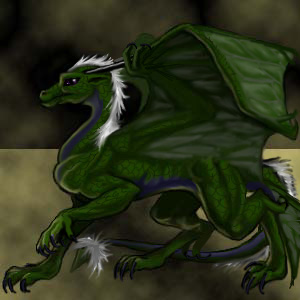 This
picture shows some distinctive features of a Dimar - six toes
on each hand and foot - not four. Each Dimar has two thumbs,
one on either side of the four main fingers. In the case of
the hindfeet, the two toes are short and double jointed, and
can flip back to become hanging claws. Dimar also have two thumbclaws
at the pinnacle of the wings. The wing bones split at the ends
to add stability to the edge of the wing. Dimar also have a
tail fan, covered in the same wing membrane to give lift to
their heavy hips and long tail. Dimar wings don't work via Bernoulli's
principal alone. They generate magnetic lift off the planet's
magnetic field (The Wind, as the Dimar call it, unlike wind,
which is just air movement). This allows them to have great
stability in churning air, although not in times of magnetic
disturbance. The lifting bodies are distributed through the
wing membrane, but can be focused into smaller organs if the
Dimar requires the ability to lift other parts of it's body.
The lifting bodies are serious energy depletors, so Humans and
Arrallins generally don't have them implanted under the skin.
Instead, they buy external wings with a separate power storage
and input system. That sounds very electronic, but Humans and
Arrallins have to feed their wings! The wings are technically
alive, but have no central nervous system, but communicate with
the spine of the human, sensing muscle and arm movements, OR,
if the individual is lucky enough to have psi abilities, it
is linked to a portion of their awareness. This
picture shows some distinctive features of a Dimar - six toes
on each hand and foot - not four. Each Dimar has two thumbs,
one on either side of the four main fingers. In the case of
the hindfeet, the two toes are short and double jointed, and
can flip back to become hanging claws. Dimar also have two thumbclaws
at the pinnacle of the wings. The wing bones split at the ends
to add stability to the edge of the wing. Dimar also have a
tail fan, covered in the same wing membrane to give lift to
their heavy hips and long tail. Dimar wings don't work via Bernoulli's
principal alone. They generate magnetic lift off the planet's
magnetic field (The Wind, as the Dimar call it, unlike wind,
which is just air movement). This allows them to have great
stability in churning air, although not in times of magnetic
disturbance. The lifting bodies are distributed through the
wing membrane, but can be focused into smaller organs if the
Dimar requires the ability to lift other parts of it's body.
The lifting bodies are serious energy depletors, so Humans and
Arrallins generally don't have them implanted under the skin.
Instead, they buy external wings with a separate power storage
and input system. That sounds very electronic, but Humans and
Arrallins have to feed their wings! The wings are technically
alive, but have no central nervous system, but communicate with
the spine of the human, sensing muscle and arm movements, OR,
if the individual is lucky enough to have psi abilities, it
is linked to a portion of their awareness.
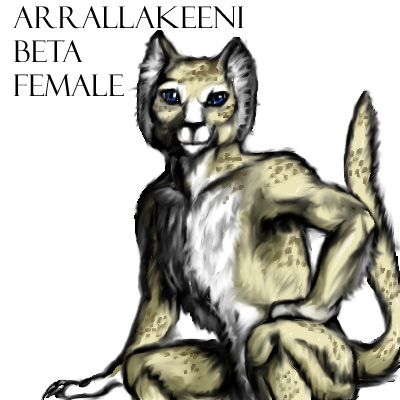 This
is an arrallakeeni beta female. Beta Arrallins don't breed on
their own - they adopt a kit from the alpha breeding pair to
raise. Keeni (as they like to call themselves), are hard workers,
incredibly adept at mechanical tasks, and dedicated family members. This
is an arrallakeeni beta female. Beta Arrallins don't breed on
their own - they adopt a kit from the alpha breeding pair to
raise. Keeni (as they like to call themselves), are hard workers,
incredibly adept at mechanical tasks, and dedicated family members.
To find out more about the Arrallin species, click
here.
More to come!
|





